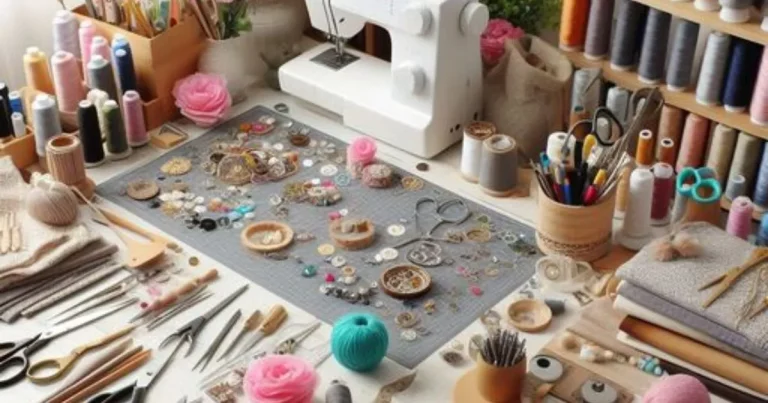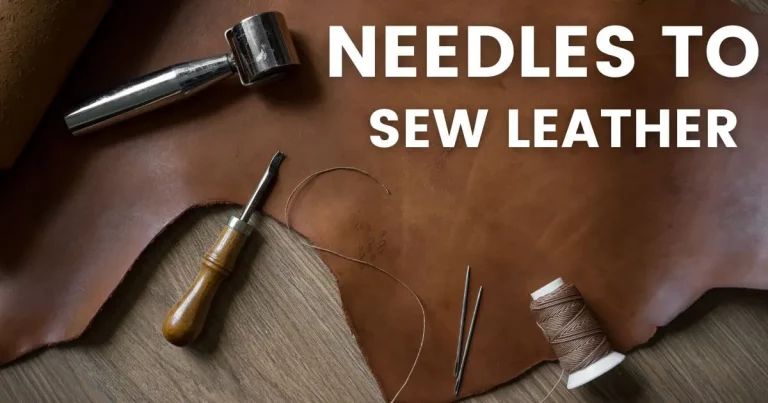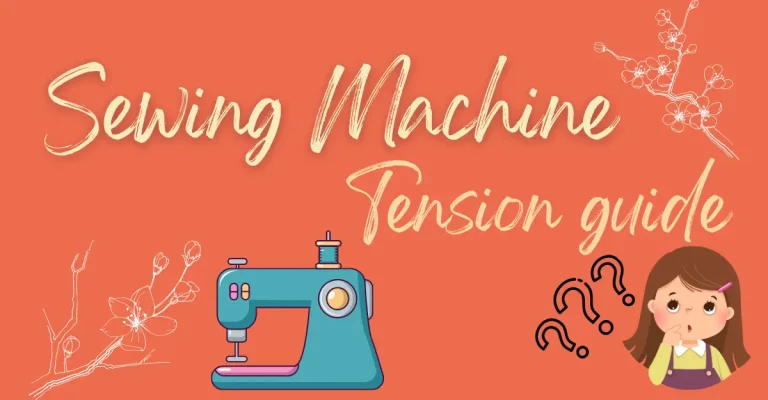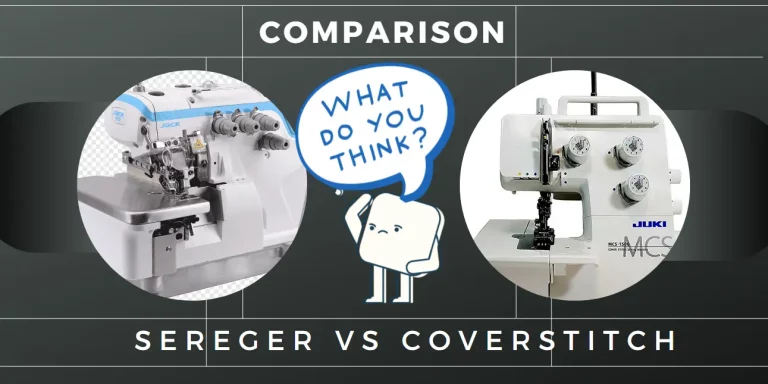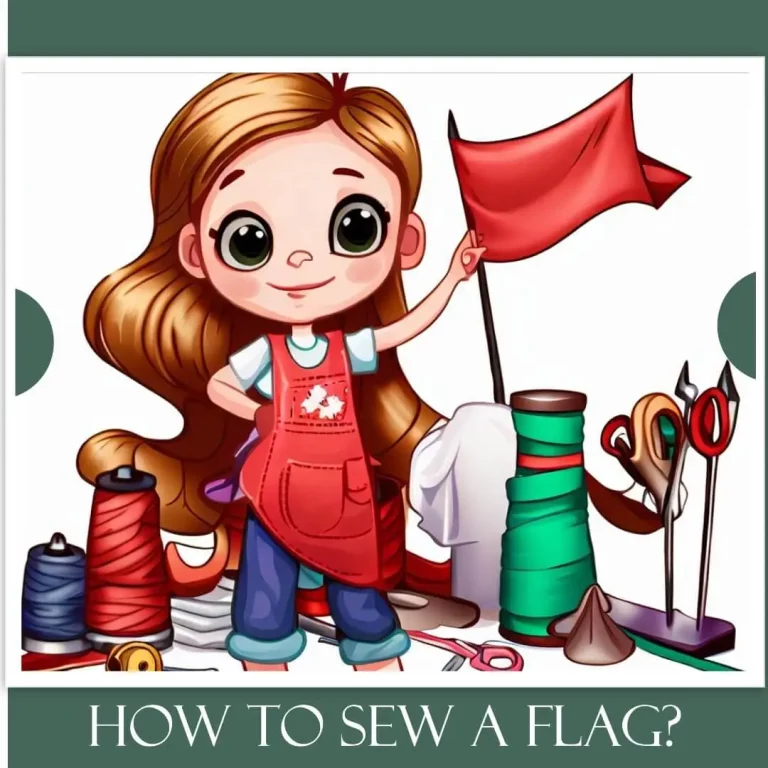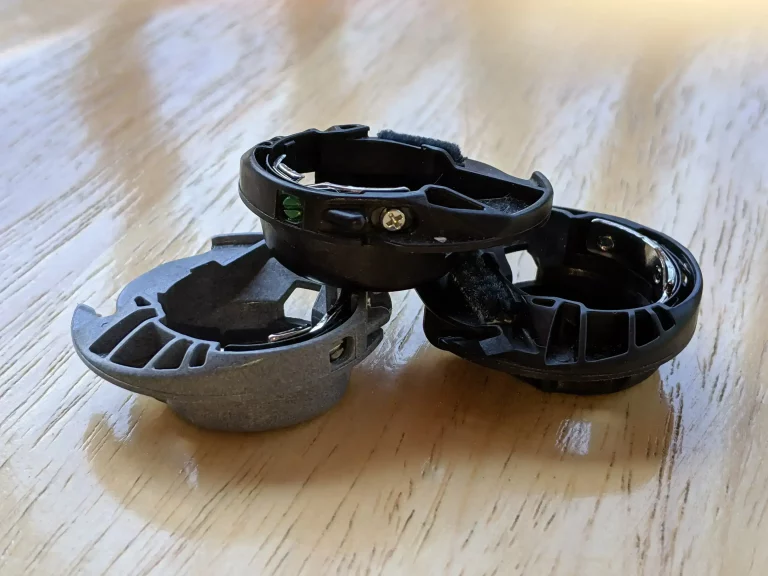8 DIFFERENT TYPES OF SEWING MACHINE: PROS, CONS & FEATURES
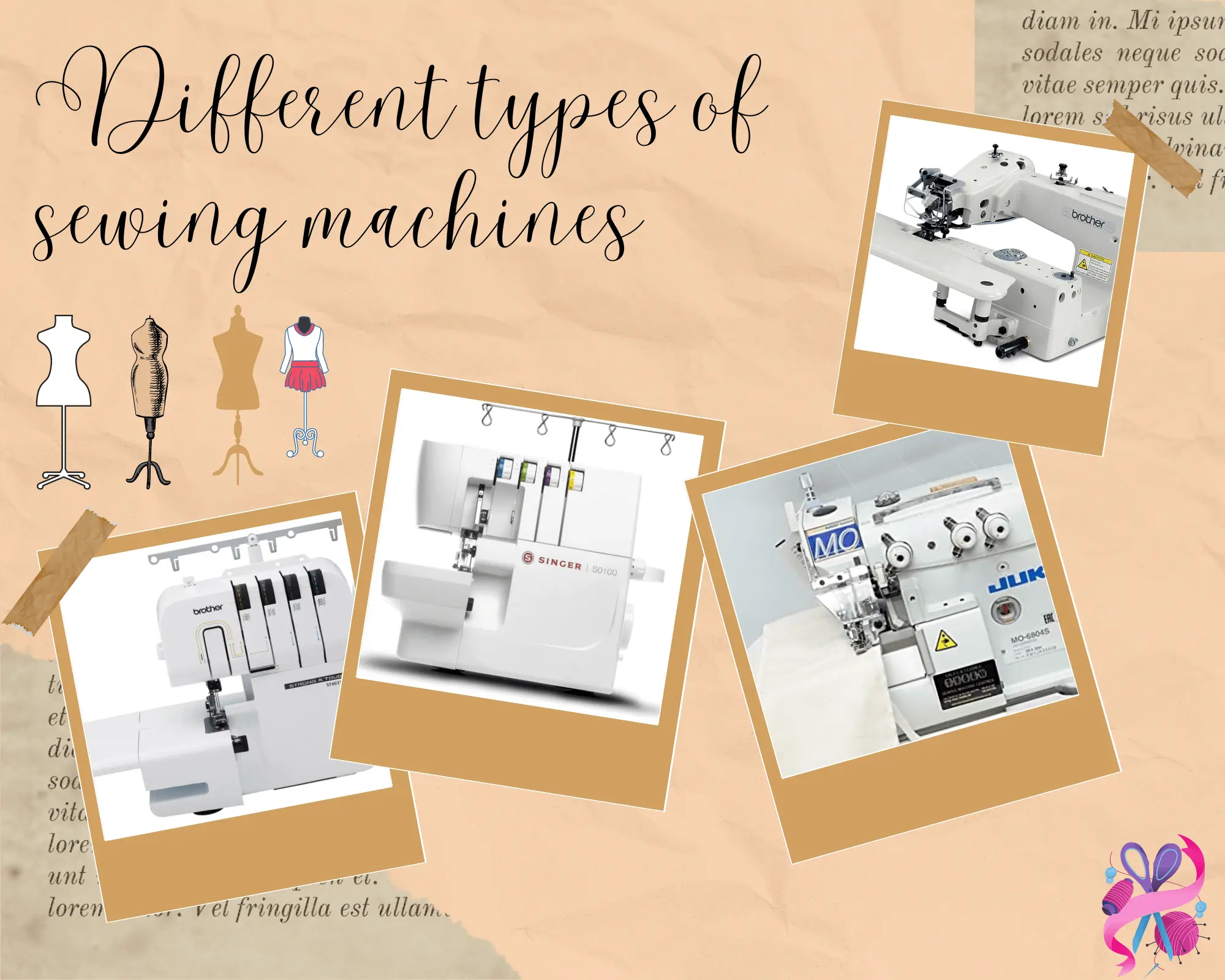
In this article, we will explore different types of sewing machines that will help you determine which one is most appropriate for your basic sewing 101 needs. There are different sewing machine types accessible on the market today, each with its own set of features and capabilities.
It can be difficult to select the best machine for your requirements, whether you’re a beginner or a seasoned sewer. From basic mechanical machines to modern ones computerized models, each variety has its benefits and disadvantages. That’s why we’ve put together this guide to help you sort through the various kinds of sewing machines.
Different types of sewing machine
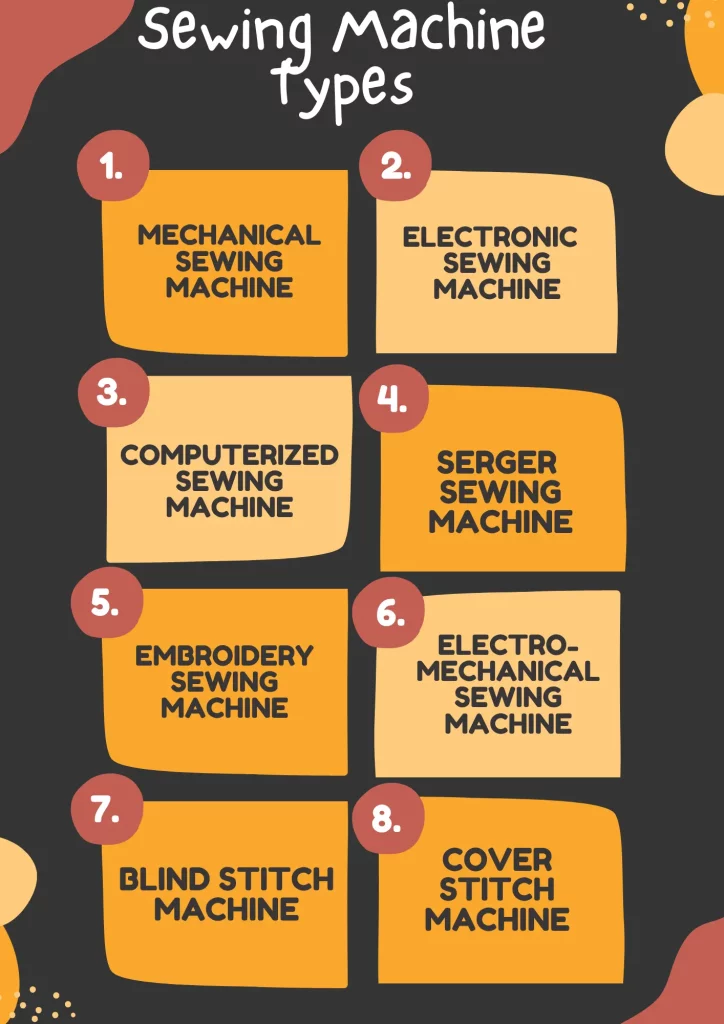
Mechanical Sewing Machines
Mechanical sewing machines are the most conventional and basic form of sewing machine. They are completely mechanical in operation, with few of electronic components. These devices are powered by a manual hand crank or foot pedal, and the operator must regulate the speed and stitch length manually. While mechanical sewing machines lack the sophisticated features of electronic or automated sewing machines, they remain popular due to their simplicity and durability.
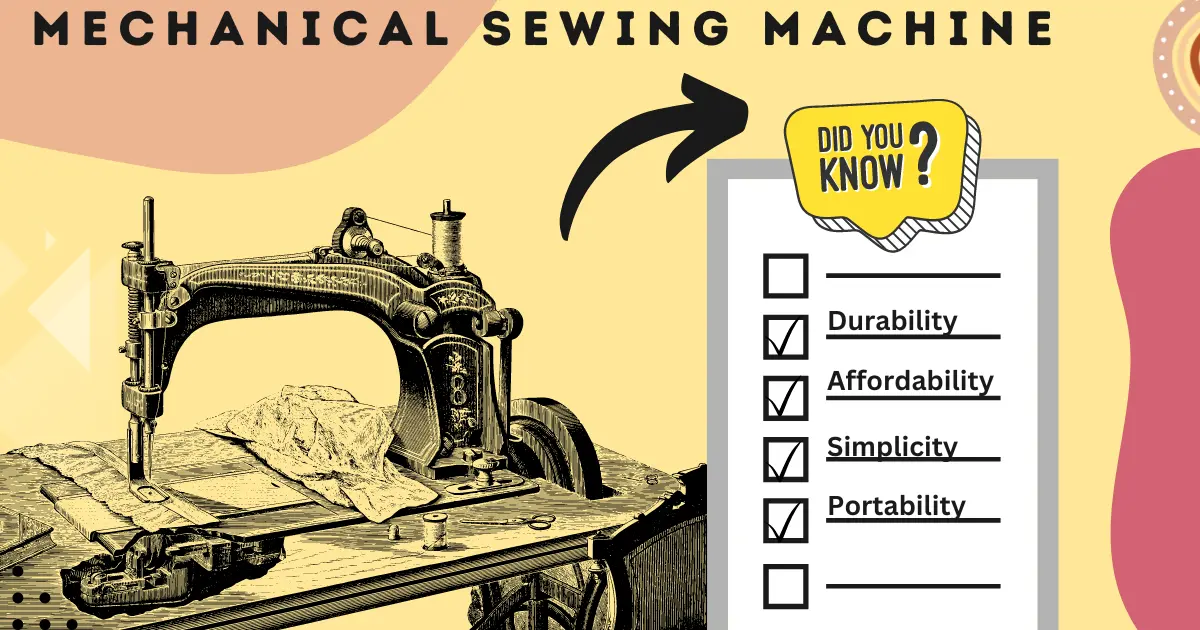
Read more: Comparing Automatic VS Manual Sewing machine
Working
When using a sewing machine, the operator must first thread the machine by winding the thread onto a bobbin and placing it into the machine. After that, they must thread the upper thread through the various guides and tension disks on the machine. Once the machine is threaded, the operator can change the stitch length by adjusting the stitch regulator lever.
To start sewing, the operator needs to place the cloth under the presser foot by pressing down on the foot pedal or turning the hand crank. As the needle moves up and down, it passes through the cloth and loops the thread around the bobbin thread. This creates the basic stitch that forms the foundation of the sewing process.
As the operator continues to sew, they can advance the cloth by repeating the previous steps. The needle enters the cloth, and the upper thread and the thread looped around the bobbin thread interlock to create a fundamental stitch. With practice and experience, the operator can create various stitch patterns by adjusting the stitch length, tension, and other machine settings.
Features
Pros
Cons
Electronic Sewing Machines
An electronic sewing machine is a particular kind of sewing machine that automates particular features and functions using electrical components and technology. Electronic sewing machines are more feature-rich and versatile than traditional sewing machines, which makes them a preferred option for both beginners and seasoned sewers. These devices increased the speed and accuracy of the sewing process. Electronic sewing machines make it simpler to consistently produce flawless stitches by automatically adjusting tension, stitch length, and breadth. Additionally, they frequently offer a broader selection of stitches that can be selected and customized using a touch screen or digital display.
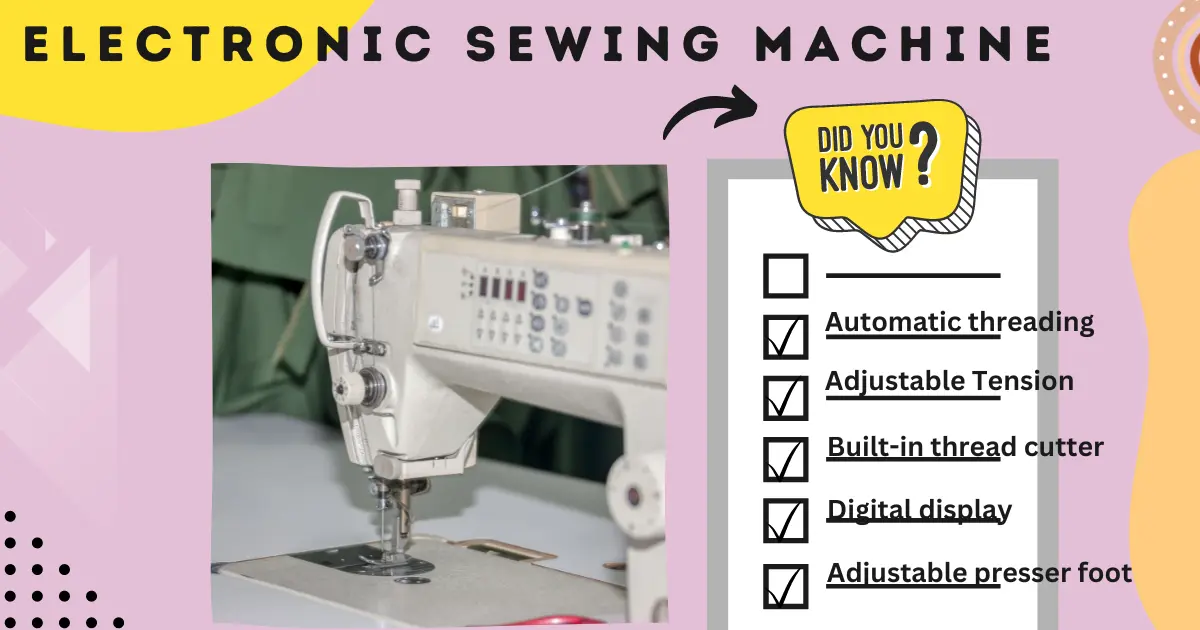
Read more: Serger VS Coverstitch Machine
Working
When using an electronic sewing machine, the machine is powered by either a battery or by plugging the machine directly into an outlet. The machine has a display screen that allows the user to select and modify various parameters, including stitch length, width, and type.
The motor of an electronic sewing machine is controlled electronically, giving it precise control over speed. This allows the user to adjust the machine’s speed more accurately than with a mechanical machine. The machine also offers many different stitch options that are easy to choose and modify through the display screen.
One of the advantages of electronic sewing machines is that they come with many automatic functions, such as buttonhole creation, thread clipping, and needle threading. Some electronic sewing machines even have a memory storage feature, which allows the user to save and recall their preferred stitch configurations.
Accessories such as presser feet, bobbins, and needles are easy to attach and swap out as required. With some high-end electronic sewing machines, users can import and create custom designs by linking the machine to a computer.
Features
Pros
Cons
Computerized Sewing Machines
Because of their high degree of precision and accuracy, computerized sewing machines are perfect for intricate sewing projects like quilting or embroidery. Computerized sewing machines have an internal processor that manages a number of operations, such as thread length, stitch width, and stitch designs. These sewing machines have LCD screens that show stitch designs and settings, making it simple for sewers to choose and alter their projects. Computerized sewing machines are a popular option for both inexperienced and seasoned sewers due to their variety of features and sophisticated technology. If you want read about Brother CS7000i Computerized sewing machine, click on the link.
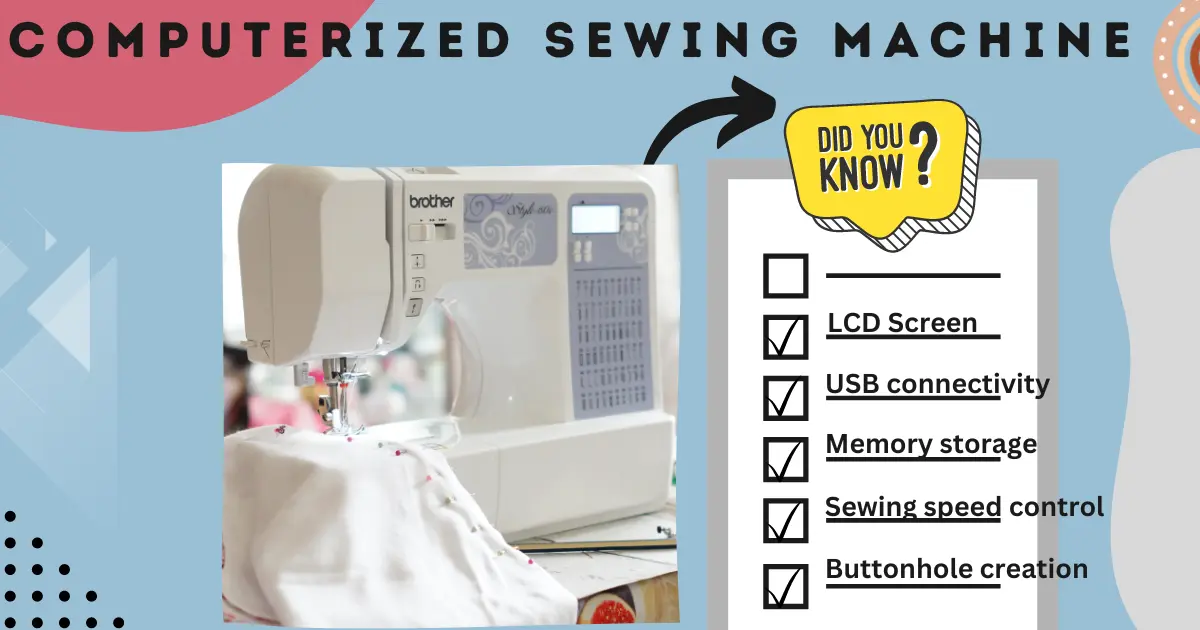
Working
When using a computerized sewing machine, the user has access to an LCD screen that displays stitch designs and settings. This screen makes it easy for the sewer to select their preferred stitch design and adjust the machine’s settings as needed.
Computerized sewing machines come with a built-in microprocessor that manages all of the device’s operations. The computer analyzes the data entered by the user and sends the required instructions to the mechanical components of the machine.
The computer-controlled motor of the machine allows for precise and reliable stitching, and the user can adjust the machine’s speed as needed. The machine also offers a variety of stitch patterns, which can be easily chosen on the LCD screen. Additionally, the user can adjust the stitch length and width to fit their preferences.
For those who want to create unique and complex designs, some computerized sewing machines allow users to design and save their own stitch patterns. The memory feature on many machines enables users to save their stitch patterns and settings, which can be helpful for those who frequently work on the same types of projects. The thread tension is automatically adjusted by the sewing machine’s computer to produce neat and even stitches. Additionally, some computerized sewing machines have a thread cutter integrated into the machine, which makes it easy for the user to cut the thread.
Features
Pros
Cons
Serger Sewing Machines
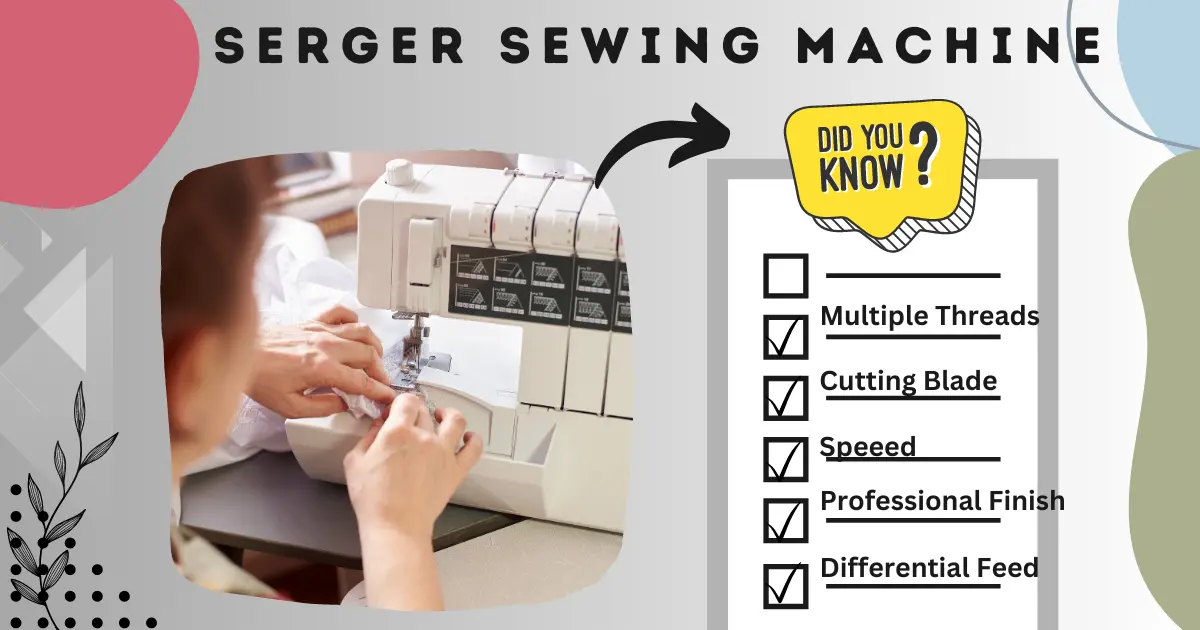
An overlock machine is another name for a serger sewing machine. It is a specialized kind of sewing machine that is used to give the edges of cloth a tidy and expert finish. In contrast to a normal sewing machine, which uses one or two threads to create a seam, a serger sewing machine uses three or four threads to create an overlock stitch that secures the edge of the fabric and trims off any extra material. There are many different kinds and models of serger sewing machines, from basic ones to more sophisticated ones that can work with a variety of fabrics and stitch types.
Working
A serger sewing machine has multiple needles and loopers that work simultaneously to trim and stitch the fabric’s borders. The process makes a crisp and neat edge by cutting the cloth as it sews. Multiple threads are used by serger machines to make a variety of stitches, such as a flatlock stitch, rolled hem, and a basic overlock stitch. These stitches give the fabric strength and flexibility and are often used to create decorative borders and finish seams on clothing.
One of the distinctive features of serger devices is the differential feed. It allows the front and rear feed dogs to move at different speeds, helping to prevent stretching and fabric distortion. This feature is particularly helpful when working with stretchy or knit fabrics.
Serger machines offer adjustable stitch width and length options, which enable users to customize their stitches based on their project requirements. Some serger sewing machine models also have a built-in cutter, which enables users to neatly complete their work by trimming the thread tails after stitching.
Overall, a serger machine is a versatile and efficient tool that helps create strong and finished seams on fabric. Its ability to simultaneously stitch and trim fabric edges allows for quick and professional-looking results, making it a popular choice among sewers and clothing designers.
Features
Pros
Cons
Read more: Brother 1034dx Serger Review
Embroidery Sewing Machines
Custom designs can be embroidered onto items of clothing, furniture, and even the production of works of art. These machines produce these patterns using a mix of manual inputs and computer technology. A growing number of people are using embroidery sewing machines because they make it simple and fast to make unique patterns on a variety of fabrics. They can be mechanical, electronic, or computerized embroidery sewing devices, among other varieties.
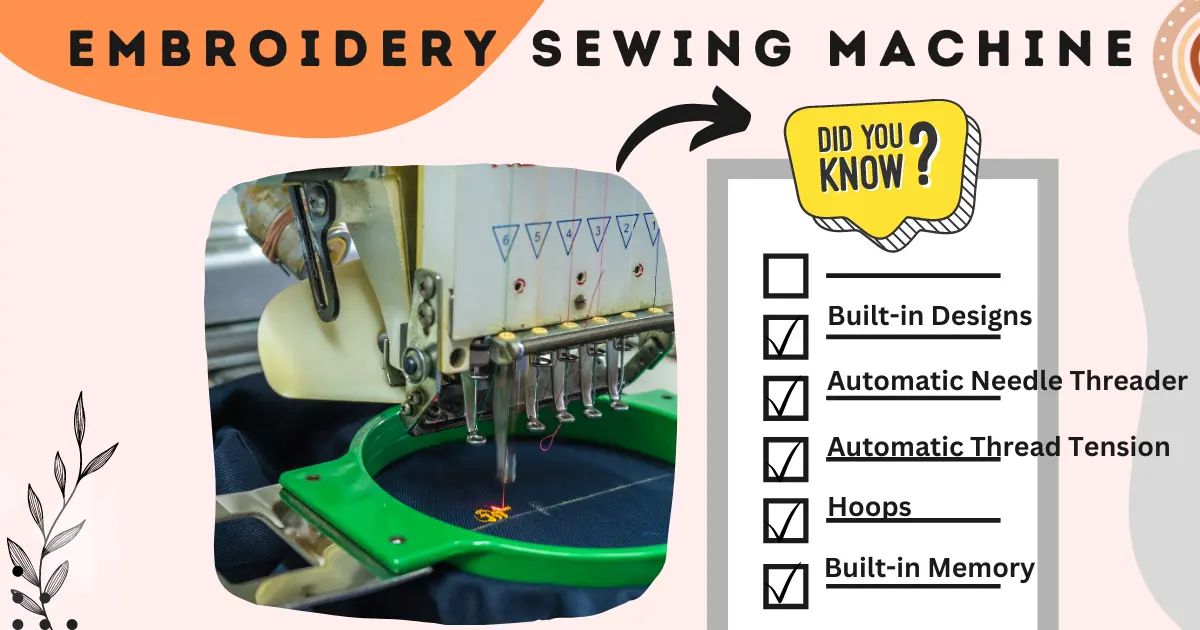
Working
Embroidery sewing machines are specialized sewing machines used to add decorative designs to fabric. These machines use different techniques to create embroidery designs. Here’s how embroidery sewing machines work
First, the user selects a design to embroider. The design may come preloaded on the machine or can be imported from a computer or digital device using USB or Wi-Fi connectivity. Once the design is selected, the user attaches the fabric to a hoop, which holds the fabric taut and in place during the embroidery process.
Next, the user threads the embroidery sewing machine with the desired thread color(s) and selects the appropriate needle. The machine’s computer then controls the movement of the needle and the fabric, creating the embroidery design.
The machine moves the fabric hoop in a specific pattern, guided by the embroidery design chosen. The needle moves up and down, stitching the design onto the fabric, and the thread is pulled through the fabric from the bobbin underneath.
Embroidery sewing machines may have a single needle or multiple needles, depending on the complexity of the design. The user can also adjust the speed of the machine to suit their preference or the needs of the project. Some embroidery sewing machines also have additional features such as automatic thread cutting and automatic needle threading, which makes the embroidery process faster and more efficient.
Features
Pros
Cons
Electromechanical Sewing machines
Sewing machines with electronic and mechanical components combined are known as electromechanical machines. It is a mechanical sewing machine that has been updated with more modern features and abilities. The motion of the needle and thread is controlled by a system of gears, levers, and cams in an electromechanical stitching machine. A foot pedal operates the machine, regulating the pace at which the fabric is fed through it.
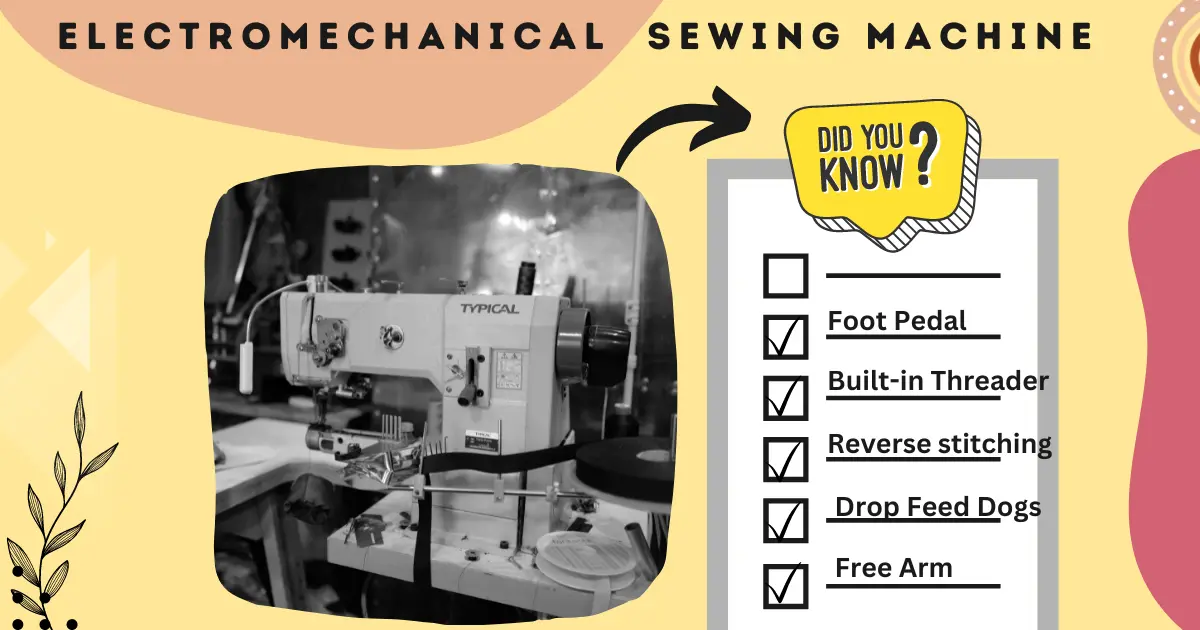
Working
When the user presses the foot pedal, an electrical current is sent to the motor, causing it to turn. The motor’s rotation drives a system of gears, belts, and pulleys that power the needle and shuttle. The needle moves up and down as the fabric is fed through the machine, creating the desired stitch pattern.
The machine’s speed can be adjusted by controlling the amount of pressure applied to the foot pedal. Different stitch lengths and patterns can be selected by manually adjusting the machine’s dials and knobs.
Electromechanical sewing machines typically have a range of accessories, including presser feet, bobbins, and needles. These parts can be swapped out as needed to suit the user’s project requirements.
Features
Pros
Cons
Blind stitch machine
A specialty sewing machine called a blind stitch sewing machine, also referred to as a blind hemming machine, is used to sew a nearly invisible hem onto textiles like pants, skirts, and curtains. To make a blind stitch, which is made by picking up just a few threads on the fabric’s visible side and then collecting more threads on the underside, the machine is outfitted with a curved needle and a guide.
Hemming light to medium-weight fabrics like cotton, wool, and linen usually involves the use of blind stitch machines. Additionally, they are employed to hem sheer materials like chiffon and georgette. Both commercial and household versions of blind stitching equipment are available.
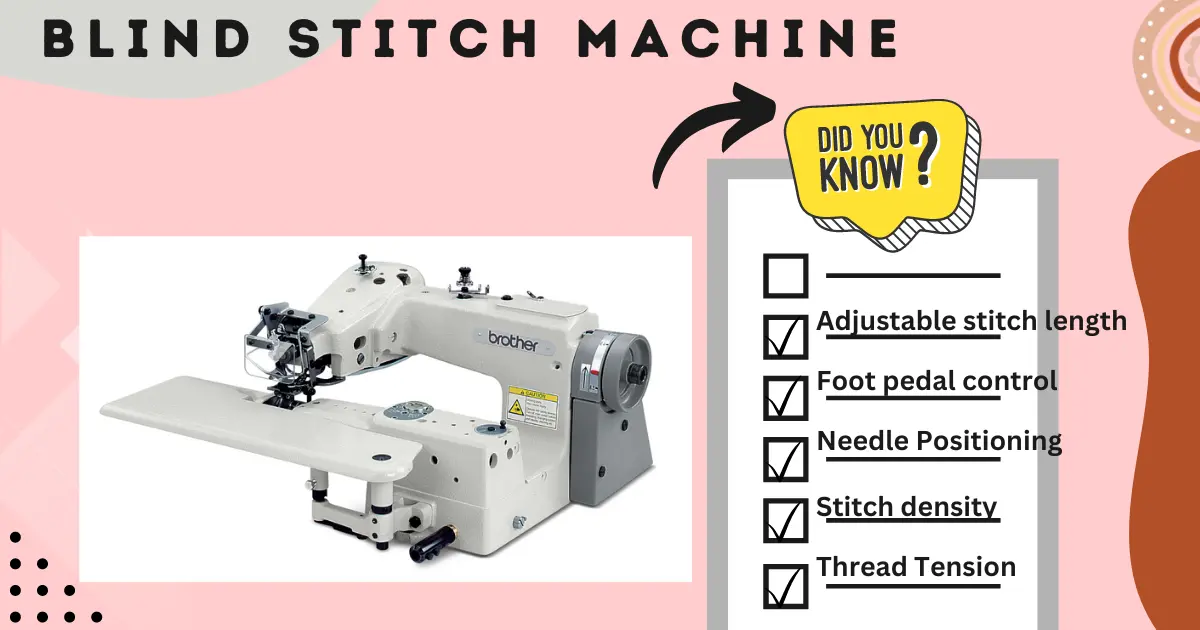
Working
To use a blind stitch machine, the user first folds the fabric to create a hem. The folded edge is then placed under the machine’s foot, and the fabric is aligned so that the edge of the hem is facing up. The user then guides the fabric through the machine, ensuring that the needle is passing through the hem’s folded edge and catching only a few threads of the fabric with each stitch.
The machine’s stitch length and depth can be adjusted to suit the fabric’s thickness, ensuring that the stitches are not visible on the outside of the fabric. Some machines also have a guide that helps the user maintain a consistent distance between the needle and the hem’s folded edge, further ensuring the quality of the blind hem.
Features
Pros
Cons
Cover stitch machine
A cover stitch sewing machine is a specific kind of sewing machine made to produce decorative stitching and professional-looking hems on a variety of textiles. A cover stitch machine, in contrast to other sewing machines, employs two or three needles and multiple threads to produce a distinctive stitch that gives the cloth a decorative appearance.
For making professional-looking clothing and items at home and in the fashion and textile industries, cover stitch sewing machines are widely used. Despite having a higher price tag than standard sewing machines, they offer a variety of features and powers that can make sewing more convenient and enjoyable.
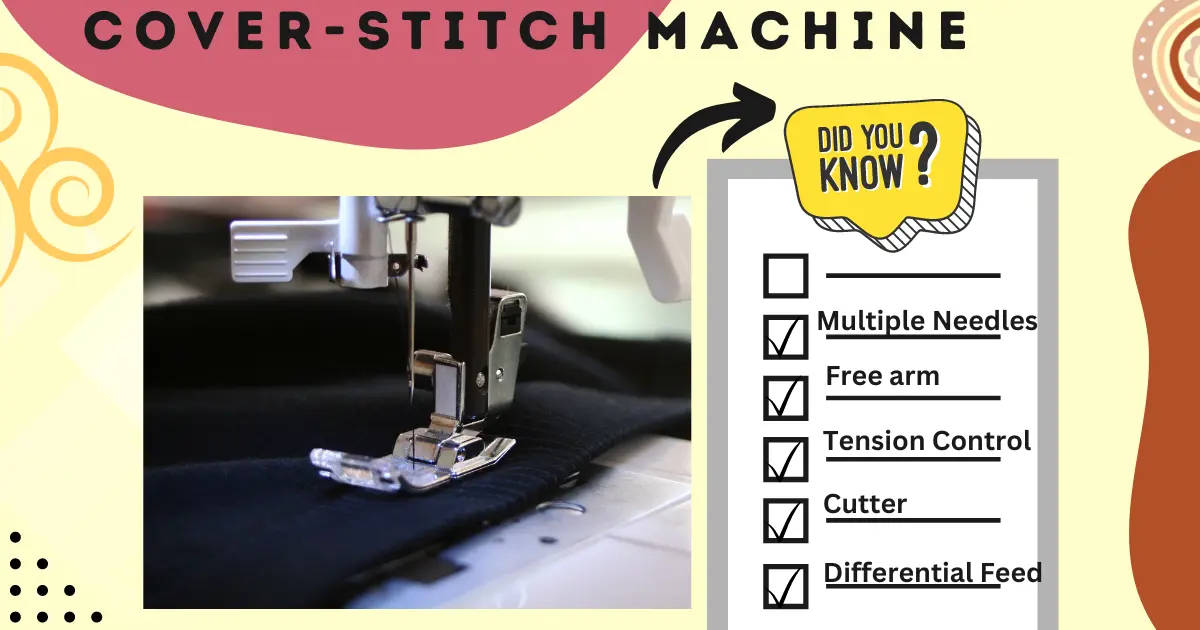
Working
The fabric is fed through the machine and held in place by a presser foot. The two needles create a parallel row of straight stitches on the top of the fabric while the looper catches the threads and creates a chain stitch on the underside. At the same time, a separate thread is used to create a zigzag stitch on the underside, which provides additional stretch and stability to the seam.
The cover stitch machine allows for adjustable stitch length, differential feed, and tension control, which enables the sewer to create a variety of professional-looking hems and seams on knit and stretch fabrics. The machine can be used for hemming, topstitching, binding, and decorative stitching, making it a versatile tool for both home sewers and professional seamstresses.
To use a cover stitch machine, the user needs to choose the appropriate needles and threads and adjust the machine settings according to the fabric and desired stitch. The fabric is then fed through the machine, and the stitch is created by the synchronized movement of the needles and looper. The end result is a professional-looking, durable hem or seam that stretches with the fabric, making it ideal for active wear, knitwear, and other stretchy fabrics.
Features
Pros
Cons
If you want to know that how would you choose the sewing machine among various types, Click on the link to read the Sewing Machine buying guide.
Conclusion
In conclusion, Among the different types of sewing machine you choice will rely on your sewing needs, skill level, and financial constraints. Every type of sewing, quilting, embroidery, and serger machine has its own distinct benefits and features, whether it is mechanical, electronic, or computerized. Before choosing a machine, it’s crucial to take your needs and tastes into account. By doing this, you can discover the sewing machine that best suits your requirements and enables you to produce projects that appear lovely and professional.

